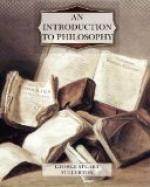One must not confound with this doctrine that very different one, Spiritism, which teaches that a certain favored class of persons called mediums may bring back the spirits of the departed and enable us to hold communication with them. Such beliefs have always existed among the common people, but they have rarely interested philosophers. I shall have nothing to say of them in this book.
There have been various kinds of spiritualists. The name may be applied to the idealists, from Berkeley down to those of our day; at some of the varieties of their doctrine we have taken a glance (sections 49, 53). To these we need not recur; but there is one type of spiritualistic doctrine which is much discussed at the present day and which appears to appeal strongly to a number of scientific men. We must consider it for a moment.
We have examined Professor Clifford’s doctrine of Mind-stuff (section 43). Clifford maintained that all the material things we perceive are our perceptions—they are in our consciousness, and are not properly external at all. But, believing, as he did, that all nature is animated, he held that every material thing, every perception, may be taken as a revelation of something not in our consciousness, of a mind or, at least, of a certain amount of mind-stuff. How shall we conceive the relation between what is in our mind and the something corresponding to it not in our mind?
We must, says Clifford, regard the latter as the reality of which the former is the appearance or manifestation. “What I perceive as your brain is really in itself your consciousness, is You; but then that which I call your brain, the material fact, is merely my perception.”
This doctrine is Panpsychism, in the form in which it is usually brought to our attention. It holds that the only real existences are minds, and that physical phenomena must be regarded as the manifestations under which these real existences make us aware of their presence. The term panpsychism may, it is true, be used in a somewhat different sense. It may be employed merely to indicate the doctrine that all nature is animated, and without implying a theory as to the relation between bodies perceived and the minds supposed to accompany them.
What shall we say to panpsychism of the type represented by Clifford? It is, I think, sufficiently answered in the earlier chapters of this volume:—
(1) If I call material facts my perceptions, I do an injustice to the distinction between the physical and the mental (Chapter IV).
(2) If I say that all nature is animated, I extend illegitimately the argument for other minds (Chapter X).
(3) If I say that mind is the reality of which the brain is the appearance, I misconceive what is meant by the distinction between appearance and reality (Chapter V).
57. THE DOCTRINE OF THE ONE SUBSTANCE.—In the seventeenth century Descartes maintained that, although mind and matter may justly be regarded as two substances, yet it should be recognized that they are not really independent substances in the strictest sense of the word, but that there is only one substance, in this sense, and mind and matter are, as it were, its attributes.




